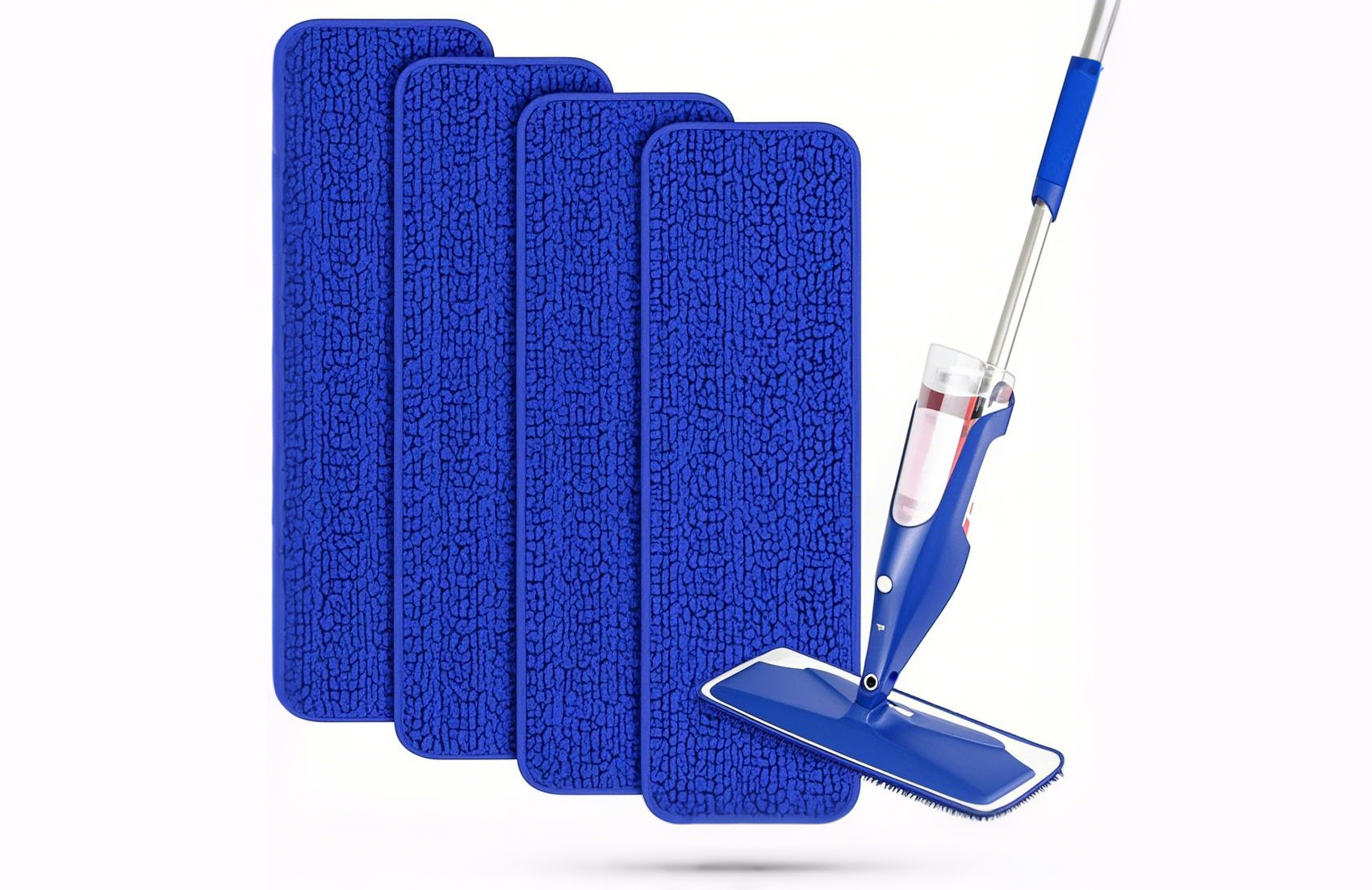Improve Hospital Hygiene with Microfiber Mop Pads

Hospitals need cleaning tools that deliver exceptional results. Microfiber mop pads meet this need by offering unmatched cleaning power. They remove up to 98% of bacteria and 93% of viruses with just water, while traditional cotton mops only tackle 30% of bacteria and 23% of viruses. This makes them the ideal hospital cleaning mop pad for maintaining a safe and sanitary environment.
Key Takeaways
- Microfiber mop pads clean 98% of bacteria and 93% of viruses with just water. They are important for keeping hospitals clean.
- Using a new Microfiber Mop pad in every room lowers the chance of spreading germs. This keeps patients and staff safer.
- Taking care of microfiber mop pads and storing them correctly makes them last longer. This also helps hospitals save money.
Why Microfiber Mop Pads Are the Best Hospital Cleaning Mop Pad

Superior Cleaning Efficiency for Hospital Floors
Microfiber mop pads excel at cleaning hospital floors due to their advanced design. These pads trap dirt, dust, and debris more effectively than traditional mops. Their tiny synthetic fibers reach into crevices and corners, ensuring no spot is left untouched. Hospitals benefit from their ability to clean various floor types, including tile, laminate, and linoleum, without leaving streaks or residue.
- Microfiber mopping systems save 95% in water and chemical usage.
- They achieve a cleaning effectiveness rate of 99.95%.
- They help reduce cross-contamination.
This level of efficiency makes microfiber mop pads the ultimate choice for maintaining spotless hospital floors.
Enhanced Hygiene and Bacteria Removal
Hospitals require cleaning tools that prioritize hygiene. Microfiber mop pads remove up to 98% of bacteria and 93% of viruses using only water. This is a game-changer compared to traditional mops, which leave behind a significant portion of harmful microorganisms. By eliminating bacteria and allergens, microfiber mop pads create a safer environment for patients and staff. Their ability to clean without harsh chemicals also reduces exposure to irritants, making them ideal for sensitive hospital settings.
Reduced Cross-Contamination Risks
Cross-contamination is a major concern in hospitals. Microfiber mop pads address this issue by using a single pad per room. Research conducted at UC Davis Medical Center shows that this practice prevents the transfer of dirt and contaminants from one area to another. Traditional mops often carry germs from room to room until cleaned, increasing infection risks. Microfiber mop pads eliminate this problem, ensuring each room remains hygienic and safe.
Tip: Always use a fresh microfiber mop pad for each room to maximize hygiene and reduce cross-contamination risks.
Eco-Friendly and Cost-Effective Cleaning Solution
Microfiber mop pads offer both environmental and economic benefits. Their reusable nature reduces waste, while their high absorbency minimizes water and chemical usage. Hospitals save money on cleaning supplies and operational costs by switching to microfiber.
| Aspect | Evidence |
|---|---|
| Cleaning Performance | Microfiber mops hold ~six times their weight in water, making them highly absorbent and effective. |
| Water and Chemical Usage | Much less water and cleaner are required compared to traditional mops. |
| Operational Costs | Reusable microfiber pads can lead to lower operational costs due to reduced need for cleaning supplies. |
| Infection Control | Microfibers contribute to better infection control in hospital settings. |
Reusable microfiber options also support sustainability and local jobs through reprocessing. Their superior cleaning performance and eco-friendly design make them the preferred hospital cleaning mop pad for healthcare facilities worldwide.
How to Use Microfiber Mop Pads Effectively in Hospitals
Choosing the Right Hospital Cleaning Mop Pad for Different Areas
Selecting the right microfiber mop pad is crucial for maintaining hospital hygiene. Different areas in a hospital require specific cleaning tools to address unique challenges. For instance, high-traffic zones like hallways benefit from durable microfiber pads that can withstand frequent use. Patient rooms, on the other hand, may require single-use mop pads to minimize cross-contamination risks.
| Evidence Description | Key Points |
|---|---|
| Risks of Relaundering | Relaundering can lead to diminished performance and quality of microfiber mops over time due to degradation. |
| Single-Use Advantages | Single-use mops reduce the risk of cross-contamination and ensure contaminants are removed effectively. |
| Performance Monitoring | Reusable mops require ongoing validation to assess their performance and contamination levels over time. |
Hospitals can also enhance cleaning efficiency by color-coding microfiber mop pads for specific areas. This practice helps staff quickly identify the right mop pad for each task, ensuring consistent cleaning standards across the facility.
Tip: Use single-use microfiber mop pads in sensitive areas like operating rooms to ensure maximum hygiene.
Proper Cleaning Techniques for Maximum Effectiveness
Using microfiber mop pads correctly can significantly improve cleaning results. Start by wetting the mop pad thoroughly, but avoid oversaturation. A damp pad ensures optimal dirt and bacteria removal without leaving excess water on the floor.
Adopt a systematic cleaning motion to maximize efficiency. A backward cleaning motion with a consistent leading edge prevents dirt from being spread around. For larger areas, the figure 8 motion works best, as it covers more ground while maintaining scrubbing efficiency. Regularly check the mop pad during cleaning to ensure it remains damp and effective.
- Begin with a damp microfiber mop pad.
- Use a backward cleaning motion with a consistent leading edge.
- Employ the figure 8 motion for larger spaces.
- Check the pad frequently to maintain its effectiveness.
Proper cleaning techniques not only improve hygiene but also extend the lifespan of microfiber mop pads, making them a cost-effective choice for hospitals.
Addressing Stubborn Dirt and High-Traffic Areas
High-traffic areas in hospitals often accumulate stubborn dirt that requires extra attention. Microfiber mop pads designed for heavy-duty cleaning are ideal for these spaces. Their high absorption rate and electrostatic charge make them effective at trapping dirt and debris.
| Factor | Description |
|---|---|
| Durability | High-quality microfiber should withstand over 200 laundering cycles while maintaining performance. |
| Absorption Rate | Influenced by material composition, fiber size, electrostatic charge, and surface area per weight. |
| Cleaning Performance | Best assessed through side-by-side tests of different microfiber products on standardized surfaces. |
| Microbial Removal | High-quality products score well in tests for removing various microbes; choose based on lab results. |
| Cost | Consider cost per use, factoring in purchase and processing costs, as well as cleaning time savings. |
| Color Coding Support | Segregating microfiber products by functional area can enhance cleaning efficiency. |
For stubborn stains, pre-treat the area with a degreaser or cleaning solution before scrubbing with a microfiber mop pad. This method ensures thorough cleaning without damaging the floor surface. Hospitals can also use color-coded microfiber pads to streamline cleaning processes and improve efficiency in high-traffic zones.
Note: Always choose microfiber mop pads with proven durability and microbial removal capabilities for high-traffic areas.
Maintenance and Care for Hospital Cleaning Mop Pads
Best Practices for Cleaning Microfiber Mop Pads
Proper cleaning practices are essential for maintaining the effectiveness of microfiber mop pads in hospitals. Start cleaning from the cleanest areas to avoid cross-contamination. Use cleaning products that eliminate 99.9% of tested viruses and bacteria. Staff should follow standardized procedures and receive ongoing training to ensure compliance with cleaning protocols.
Microfiber mop pads are designed for easy cleaning and disinfection. Launder them at high temperatures to kill germs effectively. Avoid using bleach or fabric softeners, as these can damage the fibers. Instead, wash microfiber pads in water no warmer than 200 degrees Fahrenheit and tumble dry them on low heat. These steps preserve the material's durability and cleaning power, even after multiple washes.
Tip: Invest in user-friendly cleaning products and monitor compliance to reduce healthcare-associated infection rates.
Proper Storage to Preserve Quality
Storing microfiber mop pads correctly helps maintain their quality and extend their lifespan. Keep them in a dry, well-ventilated area to prevent mold and mildew growth. Avoid stacking wet mop pads, as this can lead to unpleasant odors and fabric degradation.
Hospitals should use designated storage bins or racks to organize mop pads by type or area of use. Color-coded bins can simplify the process, ensuring staff quickly locate the right mop pad for each cleaning task. Proper storage not only preserves the mop pads but also streamlines cleaning operations.
Signs It’s Time to Replace Mop Pads
Even with proper care, microfiber mop pads eventually wear out. Look for signs like frayed edges, reduced absorbency, or difficulty trapping dirt. If a mop pad no longer cleans effectively, it’s time to replace it.
Microfiber materials are durable, but their performance diminishes after many washes. High-quality pads can withstand over 200 laundering cycles while maintaining their effectiveness. Regularly inspect mop pads for wear and tear to ensure optimal cleaning results.
Note: Replacing worn-out mop pads promptly prevents compromised hygiene standards in hospital settings.
Microfiber mop pads play a vital role in keeping hospitals clean and safe. They offer unmatched cleaning efficiency and help reduce infection risks. When used and maintained properly, they create a healthier environment for patients and staff. Investing in these tools is a smart move for healthcare facilities aiming to improve sanitation standards.
FAQ
What makes microfiber mop pads better than traditional mops?
Microfiber mop pads trap dirt, bacteria, and allergens more effectively. They clean with just water, reduce cross-contamination, and last longer, making them a superior choice for hospitals.
How often should microfiber mop pads be replaced?
Replace them when they show signs of wear, like frayed edges or reduced absorbency. High-quality pads usually last over 200 washes before needing replacement.
Tip: Regularly inspect mop pads to maintain optimal cleaning performance and hygiene standards.
Can microfiber mop pads be used on all floor types?
Yes! Microfiber mop pads work on hardwood, tile, laminate, and linoleum. Their gentle fibers clean without scratching, making them safe for various hospital flooring surfaces.
Note: Always check the manufacturer’s recommendations for specific floor types to ensure compatibility.


 Send Email
Send Email whatsapp
whatsapp









